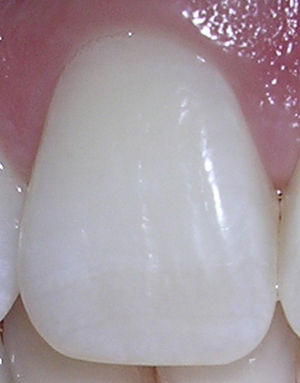Upper Central Permanent Insicor
This is pillar II. classes according to Voldřich.
The vestibular surface has a quadrangular shape, is convex and is divided by two grooves oriented longitudinally with the long axis of the tooth. These grooves gradually disappear with physiological abrasion.
The palatal plane is, unlike the labial, concave. At the neck, it becomes a distinct tuberculum dentale. On the sides of the palatal surface are the so-called enamel ridges.
The incisal edge faces the mesial surface perpendicularly, while the distal surface is rounded in the transition to the incision. The contact points between the central incisors in the upper jaw are located in the incisal third of the mesial surfaces. ![]()
The root is massive, conical, slightly curved distally and approximately circular in cross-section. The medullary cavity is first very spacious and extends into three corners. The root canal often has a circular cross-section.
Links[edit | edit source]
Related Articles[edit | edit source]
- Upper lateral permanent incisor
- Upper Permanent Canine
- Lower permanent incisors
- Lower permanent canine
Reference[edit | edit source]
References[edit | edit source]
- JANSOVÁ, K – EBER, M. preclinical dentistry : I. part - morphological. 2., dopl edition. Vydavatelství Univerzity Palackého, 1996. 72 pp. pp. 39–55. ISBN 80-7067-596-9.
- ŠEDÝ, Jiří – FOLTÁN, René. Klinická anatomie zubů a čelistí. 1. edition. Triton, 2010. ISBN 978-80-7387-312-7.


